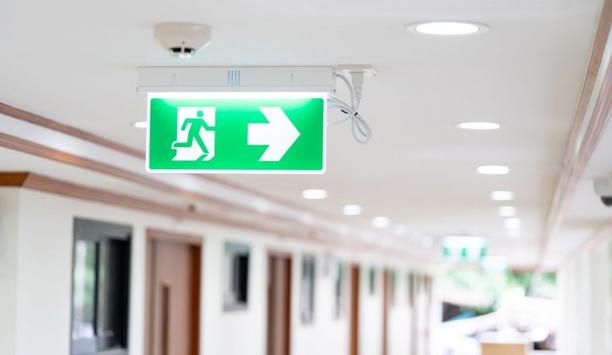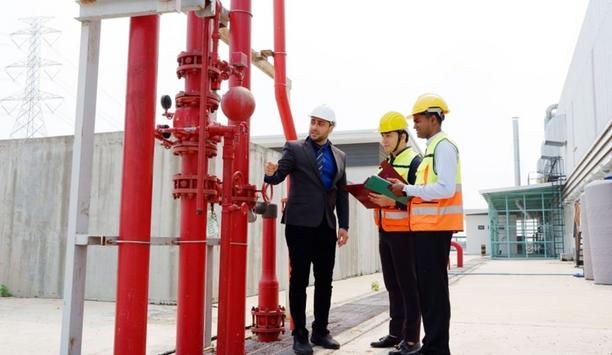Fire Rescue - Expert Commentary
Safe and seamless movement in our built environment hinges on accurately specified and installed door hardware, explains Russell Marks, managing director of Boss Door Controls. With millions of doors used each and every day, it’s important to recognize the details behind effective access and egress. Whether it’s the regular composite doors found in our homes, the electromechanical access points located in public settings, or the emergency exit fire doors that keep us safe in our wor...
The 2022 Building Safety Act, instituted in direct response to the Grenfell Tower tragedy in London, UK, has outlined a raft of new responsibilities that building owners and managers must adhere to, in line with many of the deficiencies identified post-2017. With the UK’s building stock notoriously aging, many of us live and work in buildings that were built under outdated regulations and have not been updated for decades in some cases. As such there is an enormous amount of remedia...
Are people too passive when it comes to fire door safety? Research conducted by the British Woodworking Federation (BWF) in 2022 would suggest so, with a third of the British public stating they would not report a problem with a fire door, despite three-quarters of respondents believing a propped open fire door would not perform its role in the event of a fire. From schools and shops to shared areas of employment and accommodation, people are habitually - and sometimes unknowingly - kept safe b...
When fire safety fails, lives are put at risk. In all buildings, reasonable steps must be made to reduce the likelihood and impact of fire, yet, many people remain unsure and indecisive toward fire safety practices and the roles and responsibilities associated with fire door safety. In view of this, in October 2023, new fire safety legislation was introduced to non-domestic properties in England and Wales. Section 156 of the Building Safety Act 2022 (BSA) has made a number of amendments to the...
In the challenging world of fire safety and security services, organizations are constantly juggling the need to maintain high efficiency with the relentless push for technological advancement. This industry, marked by a high volume of daily tasks and the necessity for rapid, sometimes unplanned responses, calls for robust and adaptive solutions. Yet, surprisingly, many fire safety and security engineers still rely on outdated tools like text messaging and spreadsheets. So, we must ask: is out...
The performance and reliability of fire doors can be undone by inaccurate hardware installation. Karen Trigg of Allegion UK explains the significance of installer competence and how responsible persons should approach fire door hardware fittings to ensure lives aren’t put at risk. fire doors For a building to be considered fire-safe, it must have functioning fire doors. A crucial element of passive fire protection, fire doors are recognized as a legal requirement in non-dom...
Daniel May of Consort Architectural Hardware discusses the proposed standard change from BS 476 to EN 1634-1 and the impact it may have on door hardware and the built environment should it pass. Building regulations Building regulations are designed to govern the methods and materials used throughout construction projects. For decades, modern regulations have developed to form a minimum standard and without them, many structures would be considered dangerous and risking the safety...
Sue Corrick of Allegion UK explores the evolution of panic and emergency exit hardware, examining the specification and installation points that decision-makers must consider throughout modern applications. The swift evacuation of a building and its occupants is critical in an escape or emergency situation. For decades, escape doors and exit hardware have been co-dependent in their purpose of facilitating safe egress when it matters most. Elements of public safety In fact, exit hardware has b...
Using technology to provide the information required under the new Building Safety Act 2022, which has been enforceable since October 1st, can help relieve the pressure on suppliers who are responsible for submitting the data, says Bob Glendenning, Fire Design Engineering Manager of Sherwin-Williams Protective & Marine Coatings. Building Safety Act The Building Safety Act is designed to take forward a fundamental reform of the building safety system and address the issues identi...
In the six years since the tragic Grenfell Tower disaster, the construction industry's approach to fire safety has faced rigorous examination, and sparked a series of legislative changes, most notably the enactment of the Building Safety Act and Fire Safety Act of 2022. These measures have substantially raised standards, contributing to a safer overall industry. As we approach the year’s end, assessing the industry's progress and its trajectory becomes a crucial endeavor, especially consi...
The terms under the new Building Safety Act 2022 became enforceable from October 1st this year. Here, Bob Glendenning, Fire Design Engineering Manager of Sherwin-Williams Protective & Marine Coatings, examines why creating a ‘Golden Thread’ of information within the new legislation is so important for those involved in the intumescent coatings industry. Building Safety Act 2022 The Building Safety Act 2022 (BSA) has been developed as a new framework for the design,...
With new fire safety regulations around the corner and a renewed focus on responsible persons and coordination, Karen Trigg of Allegion UK discusses the significance of fire door hardware and why regular inspections and maintenance periods must remain high on the agenda. Fire doors and their hardware are often the first line of defense in the event of a fire. Working in tandem, they coexist as a core element of a building’s passive fire protection system, providing valuable protection and...
The terms under the new Building Safety Act 2022 start to become enforceable from October 1st, 2023. Here, Bob Glendenning, Fire Design Engineering Manager of Sherwin-Williams Protective & Marine Coatings, looks at how early engagement can help engineers and those in the supply chain negotiate their way through the challenges it presents. New Building Safety Act 2022 The new Building Safety Act 2022 (BSA) has been developed as a new framework for the design, construction, and occupation...
While the technology sector was once considered the most desirable in terms of salary and job security, recent layoffs have exposed its vulnerability. Job security has always been a sought-after job benefit, and one career path that’s often overlooked is skilled trades. The skilled trades industry stands out as a resilient sector, offering the next generation of workers a promising path for growth and professional development through on-the-job experience and education. Significant tal...
Across the globe, the decarbonization of our planet has become a focal point for construction. Between legislative requirements and market demand, industry pioneers remain under constant pressure to reach environmental targets, and upon exploring some of the more distinct routes, it’s important to consider what more can be done with construction materials. Environmentally conscious products Research has shown that approximately 55% of extracted raw materials are used to develop th...
The construction sector has faced heightened scrutiny regarding its handling of fire safety in recent years. 2017’s devastating Grenfell Tower fire, served as a catalyst for reform on the testing of construction materials, building design, and construction practices, putting the focus back on occupant safety. In April this year, prominent fire service providers echoed this sentiment. They emphasized the importance of comprehensive system testing over solely examining individual comp...
The fire risks associated with multi-occupied residential buildings remain high on the sector’s agenda, and the latest wave of fire safety reforms can help address key concerns, says Karen Trigg of Allegion UK. raising fire safety standards In recent years, high-rise and high-risk building environments have been the subject of much industry focus. Where Grenfell was a catalyst for change, the incremental introduction of new reforms (such as the Fire Safety Act 2021 and Build...
It’s been three years since the National Fire Protection Association (NFPA) published the most recent edition of the wide-ranging standard that spans “the application, installation, location, performance, inspection, testing and maintenance of fire alarm systems, fire warning equipment, and emergency warning equipment and their components.” 2022 update A 2022 edition was officially published in September 2021, after thousands of hours of collaboration, review, and debate amon...
The importance of understanding the revised Code of Practice for Category 3 Control fire performance cables which reduce harmful smoke, toxic gases, and flame spread in the event of a real fire cannot be stressed enough. approved cabling These cables maintain the circuit integrity of a building providing power for essential services and fire-fighting systems for fire and rescue services to carry out a safe evacuation in the case of life safety. AEI Cables has won widespread support for our in...
As a company officer, the day will come where you and your crew are first to arrive at what looks like the beginning of a major incident. Your Battalion Chief (BC) is delayed or diverted to other incidents, so YOU are the Incident Commander (IC). How you set the table for this incident with regard to quickly setting up the Incident Command System (ICS) is critical. And how you use your channels of communication, including the ways you communicate, will be crucial to your success. Before we jump...
Electric wiring systems are mostly hidden and embedded in the construction, ceiling spaces, riser shafts, or wall cavities. Cables are installed in buildings by many different trades for different applications and often in polymeric conduit and ducting systems. What is not often realized is that the many miles of cables and many tons of plastic polymers which make up the wiring system can represent a major fixed fire load in a building. Fire Spread & Flame Retardance Most common flex...
Under guidance from the Architects Registration Board, architectural students are set for a change in curriculum. Karen Trigg of Allegion UK explores this decision and why industry collaboration is central to improving fire safety education and paving the way to a safer future. In evolving construction industry, the approach to building design is ever-shifting. Yet, as the complexity of projects intensifies, safety and sustainability remain fundamental areas of focus, and according to architect...
There’s no doubt the Building Safety Act and Fire Safety Act are driving major improvements in the construction industry’s quality and approval processes. Although the initial focus of the legislation is on high-rise residential buildings, it’s predicted to be rolled out across the entire sector soon, tightening fire safety regulations in hospitals, hotels, and commercial offices and we await the rafts of secondary legislation that will really redefine the regulatory landscape....
Following the UK Chancellor of the Exchequer Rishi Sunak’s Spring Statement on 23 March, several imminent and future changes were laid out by the UK government. This included VAT scrappage for residential energy-saving measures like heat pumps and solar panels, a 12-month cutting of fuel duty by 5p per liter, and to support the decarbonization of commercial premises, targeted business rate exemptions for eligible plant and machinery used in onsite renewable energy generation and storage....
Last year was the largest wildfire season recorded in California in modern history, with six of the top 20 largest wildfires in the state, according to the California Department of Forestry & Fire Protection (CAL FIRE). In 2020, firefighters faced a total of 9,917 wildfires that consumed a record 6,653 square miles. These fires took the lives of 33 people and damaged or destroyed 10,488 structures. Ahead of the 2022 wildland fire season, climatologists are predicting another record-shatteri...
Globally, it’s clear that devastating wildfires are now becoming commonplace. Of the top 20 largest wildfires in Californian history, six of them occurred in 2020 alone. In Australia, the story was the same – 2020 saw wildfires destroy millions of acres of land and raze billions of dollars of property. As the Earth’s temperature climbs and the effects of climate change become more apparent, there is increasing evidence that wildfires will become a greater threat, even in the U...
When public safety agencies, including police, fire, and ambulance, work together to meet the needs of a region, citizens are better protected, and a better quality of life for all is promoted. However, today’s public expectation demands agencies embrace digital transformation, for those partnerships to be effective and efficient and vitally, connected with the public they serve. This can involve the integration of operational systems, such as computer-aided dispatch (CAD) in a public saf...
Technological advances in recent decades have considerably improved fire alert systems. Fire sprinkler systems are now installed at a rate of 40 million units per year and now, 96% of buildings covered by sprinkler systems are potentially able to control fires without additional aid. The next step is predictive fire alarm maintenance, better fire detection, and more effective fire fighting. These capabilities rely on assessing massive amounts of data in realtime to enable predictive maintenance...
As recent news headlines have shown, the construction industry is still in need of major improvements to fire safety protocols and building standards. With new legislation on the horizon, it’s now imperative companies do all they can to guarantee end-user safety. So, how is digital construction helping to improve fire safety? Matt Ryan, UK Country Manager at PlanRadar, explains how some of the latest digital tools are helping to join the dots in safety inspection and compliance. High ri...
Workplace emergencies come in all shapes and sizes, including fires, explosions, floods, hurricanes, tornadoes, toxic material releases, radiological and biological accidents, civil disturbances, workplace violence, etc. All of which, according to the Occupational Safety & Health Administration (OSHA), require an emergency action plan. Willfully violating that requirement and not having an emergency action plan that is current, well understood and accessible, could result in a fine of US$ 1...
The New Future For Fire Agencies
DownloadThe Eight Key Trends in Fire Detection in 2023
DownloadA Digital Platform to Improve Fire Safety Compliance and Inspections
DownloadOvercoming the Challenges of Fire Safety in the Paper Industry
DownloadCarbon Monoxide: Creeping Killer Caught In The Act
Download

































